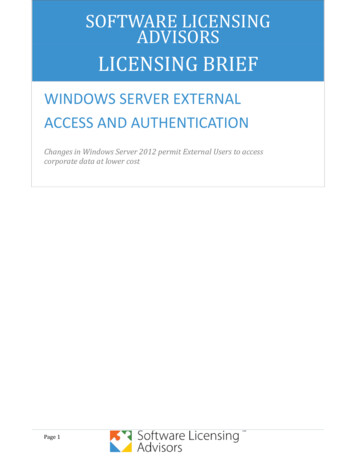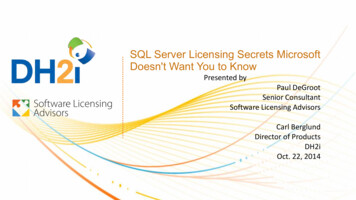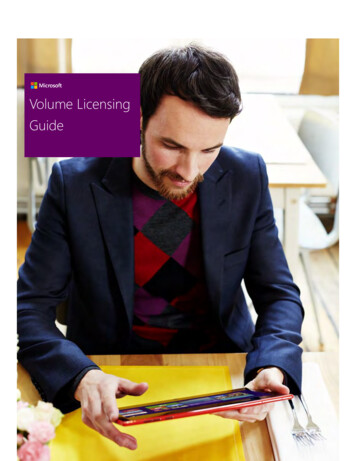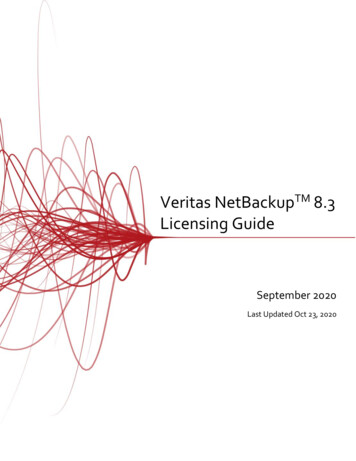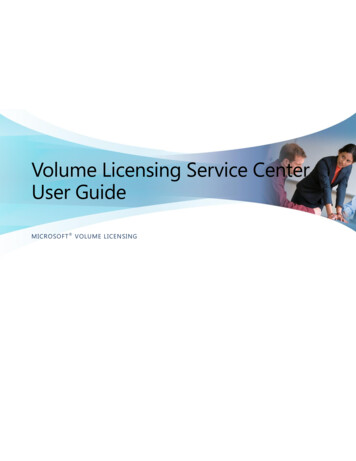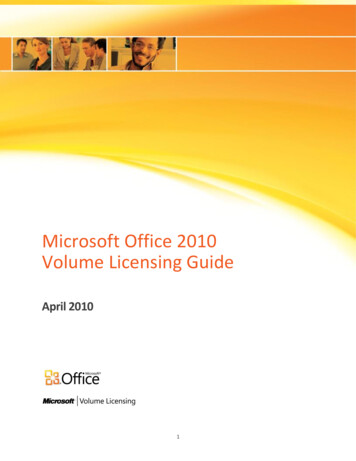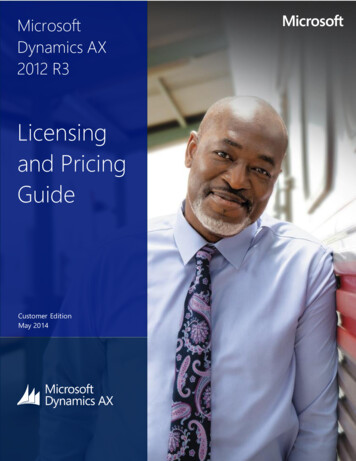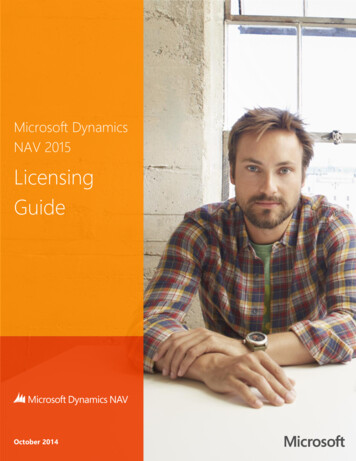
Transcription
Microsoft DynamicsNAV 2015LicensingGuideMicrosoft Dynamics NAV 2015 Licensing Guide October 2014October 2014Page 1
Using This GuideUse this guide to improve your understanding of how to license Microsoft Dynamics NAV 2015 under the PerpetualLicensing model. It does not apply to Microsoft Dynamics GP, Microsoft Dynamics AX, Microsoft Dynamics SL, or priorversions of Microsoft Dynamics NAV. This guide is not intended to influence the choice of Microsoft Dynamicsproducts and services. The examples presented in this guide are illustrative. Microsoft Corporation reserves the rightto review and/or update the existing version of this document without any advance notice.For help determining the right technology solution for any given organization, including the license requirements fora specific product or scenario, consult with your Microsoft Dynamics Certified Partner or your Microsoft account team.This guide does not supersede or replace any of the legal documentation covering use rights for Microsoft products.Specific product license terms are detailed in the Software License Terms (SLT) document, which is available athttp://go.microsoft.com/fwlink/?LinkID 512804&clcid 0x409 .License Keys vs. License EntitlementsAn important distinction to make is between license keys (activation keys) and license entitlements. You use licensekeys to activate the Microsoft Dynamics software. License entitlements are what you are entitled to run and use basedon the licenses you have acquired as described in the SLT.Since the release of Microsoft Dynamics NAV 2013 R2 CU10, license keys are version-specific. A Microsoft DynamicsNAV 2015 license key is required to activate Microsoft Dynamics NAV 2015 software and a Microsoft Dynamics NAV2015 license key will not activate any other versions of the software.ContentsOverview of Microsoft Dynamics NAV 2015 Licensing Requirements . 3Licensing the Solution Functionality . 3Licensing User Access to the Solution Functionality . 3Licensing Models. 6Perpetual Licensing . 7Licensing the Solution Functionality under Perpetual Licensing . 7Licensing User Access under Perpetual Licensing . 8Subscription Licensing . 9Subscription Licensing Term . 10Enhancement Plan Benefits .10Licenses for Additional Software .11Additional Resources .12Appendix A: Limited User Included Tables .13Appendix B: Microsoft Dynamics NAV 2013, 2013 R2, and 2015 Functionality Map .14Microsoft Dynamics NAV 2015 Licensing Guide October 2014Page 2
Overview of Microsoft Dynamics NAV 2015Licensing RequirementsMicrosoft Dynamics NAV 2015 licensing is designed to help small and midsize businesses jumpstart theirfinancial insights and distribution management and then easily extend into all functional areas.The two license models available for Microsoft Dynamics NAV 2015 provide customers with a simplified,yet flexible, purchase experience. The entire solution can be licensed with as little as one and as much asfour core components: The Starter Pack, the Extended Pack, the Full User and the Limited User. Additionalconfiguration components are also available.With Microsoft Dynamics NAV 2015, you must license: The solution functionality; and Access to the solution functionality by your usersLicensing the Solution FunctionalityMicrosoft Dynamics NAV 2015 functionality is delivered through the Starter Pack and the Extended Pack.The required Starter Pack gives you core financials and distribution functionality to help you: Gain control and insights over your finances Manage sales items and materials in a distribution environment Provide licensed users a singular view of the business from virtually anywhere through a varietyof devicesThe optional and additive Extended Pack adds functionality that integrates core financials anddistribution management capabilities with industry specific functionality extensions such as: Manufacturing to support and control the manufacturing environment Warehousing to manage the warehouse to support operations Professional Services to manage the billables generated by consultants Basic Customer Relationship Management (CRM) to manage customer and supplier relationshipsand offer the highest quality of service and supportNote: Licenses for additional software required to run the solution, such as Microsoft Windows Server, Microsoft SQLServer, and Microsoft SharePoint Server, are not included with the Starter Pack, the Extended Pack, or any of theaccess licenses. You need to license any additional software according to their applicable license terms. See Licensesfor Additional Software for more information.Licensing User Access to the Solution FunctionalityUsers accessing the solution must be defined according to the type of access they need: Full or Limited.Microsoft Dynamics NAV 2015 Licensing Guide October 2014Page 3
Figure 1: Full vs. Limited User LicensesFull Users receive unrestricted direct or indirect access to all of the functionality in the licensed serversoftware including setting-up, administering, and managing all parameters or functional processes acrossthe ERP Solution. Full Users require more write capabilities that those available to Limited Users.Limited Users get restricted access to the ERP Solution to complete only the following tasks: “Read” access to any data contained in the ERP solution; and “Write” access to a maximum of 3 table objects with the following exceptions: Limited users are not authorized to write directly or indirectly to the following tables:General Ledger Entry (table number 17), Permission Set (table number 2000000004),Permission (table number 2000000005) or Access Control (table number 2000000053);and Tables described in Appendix A: Limited User Included Tables do not count towards the 3table objects.Writing the transactions of a Limited User to a temporary table then having a Full User (or a systemprocess) post those transactions to table 17 is an example of indirect write access to table 17, which is notpermitted. Transations created by a Limited User are not considered indirect write access if (i) they areneeded by a Full User as in an input to perform their job function and (ii) transactions are processedindividually (not in a batch).Any access beyond these limitations requires Full User access.When assigning security rights to users, the system administrator will designate them as Full Users orLimited Users.Access License TypesMicrosoft Dynamics NAV 2015 offers two types of access licenses : Concurrent Client Access Licenses(CALs), only available under the Perpetual Licensing model, and User Subscription Access Licenses(SALs), only available under the Subscription Licensing model.Concurrent CALs are based on the number of users accessing the solution simultaneously. While thisaccess license type allows an unlimited number of individuals to be defined in the system, the number ofindividuals accessing the solution at any given time may not exceed the total licensed number ofConcurrent CALs. Concurrent CALs are assigned temporarily to an individual user for the duration of theiractive session. Once that individual ends the active session, the CAL then becomes available for use byanother individual. Concurrent CALs license individual users to access the application only while they areconsuming one of the Concurrent CALs (making it unavailable for other individuals to access theapplication) .Microsoft Dynamics NAV 2015 Licensing Guide October 2014Page 4
User SALs, only available in the Subscription Licensing model, grant individual users the right to accessthe application irrespective of the number of users simultaneously accessing the application. UnlikeConcurrent CALs, a unique User SAL must be assigned to each individual user that will access the solutionfunctionality. SALs are specific to an individual and cannot be shared.Refer to the Perpetual Licensing and Subscription Licensing Models section later in this document foradditional details.Access by External UsersYour customers are external users. The Starter Pack includes the rights for an unlimited number ofexternal users to access the ERP solution without the need for individual Access Licenses as long asfollowing two restrictions are met: External users cannot use any clients provided by the Microsoft Dynamics NAV ApplicationProgramming Interface (API), such as the Microsoft Dynamics NAV 2015 Windows client, theMicrosoft Dynamics NAV 2015 Web client, the Microsoft Dynamics NAV for Modern Windowsapp, the Microsoft Dynamics NAV for iPad app, or the Microsoft Dynamics NAV for AndroidTablet app. External user licenses cannot be used by you to provide business process outsourcing services toyour customers.Your system administrator designates external users in the user table by assigning such users an ExternalUser designation.Figure 2: Internal vs. External UsersMultiplexingMultiplexing is the use of hardware or software (including manual procedures) to reduce the number ofusers that directly access the Microsoft Dynamics ERP solution by pooling connections. Multiplexing doesnot reduce the number of Access Licenses required. Any user that directly or indirectly reads from orwrites to the ERP solution’s database in real-time mode or via batch whether connecting individually orthrough a data consolidation process must be licensed with the appropriate access license type incompliance with the Software License Terms.Note: Licensed users may manually rekey information (coming from non-licensed users) into the Microsoft DynamicsERP solution. This scenario is not considered to be multiplexing.Microsoft Dynamics NAV 2015 Licensing Guide October 2014Page 5
Figure 3: MultiplexingMultiplexing does not reduce the number of user licenses required.Customizing the ERP SolutionA suite of tools is available to help partners customize your ERP Solution. Your partner may licenseapplication objects as needed to modify the solution to your specific requirements. If you are a largercustomer with your own IT department, please ask your partner about Application Builder and SolutionDeveloper, two functionality modules designed to give you the tools to modify your solution on yourown.Figure 7: Adding CustomizationLicensing ModelsMicrosoft Dynamics NAV 2015 is licensed through one of two licensing models: Perpetual Licensing andSubscription Licensing.With Perpetual Licensing, you license the software with permanent usage rights. So, you can use thelicensed version of the software for as long as you choose. Perpetual Licensing might be for you if youprefer an upfront investment or if you want to manage the solution internally, and will run the software onyour premises (or, subject to license mobility rights, have it hosted by a third party Infrastructure as aService [IaaS] provider acting as your agent).Microsoft Dynamics NAV 2015 Licensing Guide October 2014Page 6
With Subscription Licensing, you license non-perpetual rights to use the software, meaning you can usethe software only during the term of the agreement secured by periodic payments. This model lowersyour initial licensing costs and provides you with the flexibility to increase or decrease subscription licensecounts from one subscription term to the next. You can use Subscription Licensing when you want to havethe ERP solution hosted and managed as Software as a Service (SaaS) by your partner or any third party.Alternatively, the software may be deployed on your premises, provided that your Microsoft DynamicsNAV partner provides day-to-day management services and maintains sole control over the solution.There are significant licensing differences between Perpetual Licensing and Subscription Licensing, asillustrated below.Figure 4: Perpetual and Subscription Licensing at-a-glancePerpetualSubscriptionSelf-managed, on-premises deploymentSelf-managed, hosted deployment (IaaS)*Partner-managed, on-premises deploymentPartner-managed, partner-hosted deployment (SaaS)Own your licensesLease your licensesConcurrent access licensesPer User access licenses*Requires an active enhancement PlanPerpetual LicensingWith Perpetual Licensing, you license the desired solution functionality and access to that functionality issecured by licensing access licenses.Licensing the Solution Functionality under Perpetual LicensingIt is now easy for small and midsize businesses to quickly and affordably get started with PerpetualLicensing. The Starter Pack gives customers all application setup utilities, provides usage rights to coreFinancials and Distribution functionalities, plus includes the first three Full Concurrent CALs. You need onlyone Starter Pack license per ERP Solution deployment—even if your installation is deployed over multipleservers as long as you own those servers and that they are in the same physical location. For manyorganizations, the Starter Pack is the only Microsoft Dynamics license component they will need.Figure 5: Starter PackIf you want to deploy some of the advanced functionality delivered by Microsoft Dynamics NAV 2015, youcan license the optional and additive Extended Pack.When you license the Extended Pack, the first three Full Concurrent CALs included in the prerequisiteMicrosoft Dynamics NAV 2015 Licensing Guide October 2014Page 7
Starter Pack also get access to all of the advanced functionality.Figure 6: Extended PackIf you have more than three Full Users that need to access the solution functionality at the same time, youmust acquire additional Full Concurrent CALs beyond the first three included with the Starter Pack.Deploying Your Self-Managed Solution in an IaaS EnvironmentIf you have an active enhancement plan, you have the licensing flexibility you need to manage your ownsolution, but deploy it in an Infrastructure as a Service (IaaS) environment, such a Microsoft Azure.Through the License Mobility rights included with your enhancement plan, you may reassign your ERPsolution licenses to: Any servers running physical operating system environments (OSEs) or virtual OSEs dedicated toyou and located within the same Server Farm as often as needed, or From one Server Farm to another, but not on a short-term basis (i.e., not within 90 days of the lastassignment).Microsoft Dynamics NAV 2015 may be deployed in a multitenant environment where, by definition, theOSE is not dedicated to you. In such case, you are required to install your license key in the tenantdatabase. Please note that this exception to the License Mobility requirement that the OSE be dedicatedto you only applies to the Microsoft Dynamics NAV software and not to any of the other Microsoftcomponents required for your ERP solution to run.Also, please note that SQL Server Runtime Use licenses, offered in Order Central, do not qualify forLicense Mobility rights. So, if you are deploying your ERP solution in an IaaS environment, you will berequired to license SQL through other licensing programs.“Server Farm” means a single data center or two data centers each physically located: In a time zone that is within four hours of the local time zone of the other (Coordinated UniversalTime (UTC) and not DST), and/or Within the European Union (EU) and/or European Free Trade Association (EFTA).Licensing User Access under Perpetual LicensingUnder Perpetual Licensing, you license Full access to the solution with Full Concurrent CALs and LimitedMicrosoft Dynamics NAV 2015 Licensing Guide October 2014Page 8
access to the solution with Limited Concurrent CALs. When assigning security rights to users, the systemadministrator will designate each user as a full user or a limited user.Microsoft Dynamics NAV 2015 contains two concurrency “counters”— one for Full Users and another onefor Limited Users—to help you make sure that the number of users concurrently logged into the solutiondoes not exceed your licensed number of Full and Limited Concurrent CALs. When a user attempts to login, they will automatically be routed through the appropriate counter based on their assigned user type. Ifthe maximum number of licensed concurrent users has already been reached, the user will not be able tolog in until someone logs out.Note: When a Full User accesses a session using web services, the session is “locked” to that user for a minimum oftwo hours, after which time, if the user has logged out, the session becomes available to other users. For LimitedUsers, the session is tied to that user for a minimum of 15 minutes. The user may release the locked session at anytime by logging into the solution through any of the Microsoft Dynamics NAV clients and logging out. At that time,the application will release all sessions tied to that user.Please note that users accessing the application indirectly, such as through a third party application, require to belicensed with and consume the appropriate CAL type, even if those users are not directly logging into the ERPsolution. The responsibility for ensuring proper concurrency usage falls to the third party application provider.Subscription LicensingWith Subscription Licensing, customers subscribe to the rights to use Microsoft software and servicesinstead of owning them.Solution Functionality and User Access are licensed through three Subscriber Access Licenses (SALs): Standard User SAL is a required SAL that entitles the licensed user to perform Full User tasksacross the ERP Solution using all of the functionality included in the Starter Pack. Every Full Userrequires a Standard User SAL. The Standard User SAL grants all licensed users the right to use thefunctionality contained in the Starter Pack. Extended Use Additive SAL is an optional functionality license type, additive to the StandardSAL, which expands the rights of all licensed users to perform tasks using all of the functionality inthe Extended Pack. The Extended Use Additive SAL grants all licensed users the right to use thefunctionality contained in the Extended Pack as long as every Full User licensed with a StandardUser SAL is also licensed with an Extended Use Additive SAL. Limited User SAL is an optional access license type that entitles the licensed user to performLimited User tasks across the ERP Solution using the same functionality footprint available to theFull Users. Every Limited User requires a Limited User SAL.Refer to Appendix B: Microsoft Dynamics NAV 2015 for Subscription Functionality for a list of the includedfunctionality in the Starter Pack and Extended Pack.Choosing the Appropriate SAL TypeTo choose the appropriate SAL type, determine the functionality you require for the ERP solution. If yourequire only the functionality included in the Starter Pack, then license Standard User SALs (or acombination of Standard User SALs and Limited Use SALs). If you also require the functionality of theExtended Pack, then license Extended Use Additive SALs for all Standard User SALs.Note: You must license Extended Use Additive SALs in the same quantity as Standard User SALs.Microsoft Dynamics NAV 2015 Licensing Guide October 2014Page 9
Figure 7: Choosing the appropriate SAL typeNote: Microsoft Dynamics NAV 2015 includes at no charge, one SAL for an External Accounting User using the clientsoftware only for the sole purpose of providing supplemental professional accounting or bookkeeping servicesrelated to the auditing process, and one SAL for a System Administor User for an employee of your MicrosoftDynamics partner to manage your application and provide support.Subscription Licensing TermMicrosoft Dynamics NAV 2015 is licensed on a monthly basis, giving you the flexibility to adapt your SALcounts from one month to the next as required by your changing business trends.When adding SALs, the cost of the license will be pro-rated based upon the time remaining in the currentmonth’s term (based on a standardized 30 day month). So, for example, if there are 10 days left until theend of the term, you will pay the monthly charge divided by 30 times 10. When removing SALs, thereduced SAL count takes effect at the start of the subsequent monthly term.The only commitment for Subscription Licensing is a full month term so, except for having to let yoursubscription run its course until the end of the current term, you can cancel at any time without anypenalties.Enhancement Plan BenefitsYour Microsoft Dynamics solution puts you at the top of your game—and your Microsoft Dynamicsservice plan keeps you there. It’s what you need to stay compliant, stay competitive, and get the greatestvalue from your solution over time. Your plan, along with the services your Microsoft Dynamics partnerprovides, will give you the winning combination for success! License Mobility Rights: Deployment flexibility for the Perpetual Licensing model that enablesyou to manage your own solution yet host it in an Infrastructure as a Service (IaaS) environment,such as Microsoft Azure. Optimizing ongoing value: Access to new version upgrades, features, and innovative capabilitieshelp customers remain compliant and competitive—and stay on the leading edge of technology. Protecting your investment: Ready access to service packs and hotfixes keep customer’s solutionup-to-date and running at peak performance levels. Microsoft ensures support throughout theMicrosoft Dynamics NAV 2015 Licensing Guide October 2014Page 10
solution’s life cycle, and the Microsoft product roadmap helps customers plan for the future. Increasing business productivity: Self-support tools and training through CustomerSourceempower customers to increase productivity and manage complex business challenges. Offering powerful flexibility: Customers decide the level of help they need, with a rich self-helpknowledge base, tremendous training resources, an online community of users, and 1:1 help fromMicrosoft experts.If you license your solution under the Perpetual Licensing model, additional Customer Support offeringsmay be available in your region. For information on the availability of the Advantage Plus Plan, or formore detailed information on the benefits, visit rvice-plans.aspx.Licenses for Additional SoftwareLicenses for additional software that may be required for the solution—such as Microsoft Windows Server,Microsoft SQL Server, and Microsoft SharePoint Server—and their corresponding Access Licenses are notincluded with the Microsoft Dynamics NAV 2015 licenses. You must acquire any necessary licenses forthese additional products under the licensing model for the particular product (which may be differentthan the model used for Microsoft Dynamics NAV 2015). To learn more or acquire licenses for additionalsoftware, find and contact a Microsoft Volume Licensing partner how-to-buy.aspx.Figure 8: Licenses for Additional Software are not included with Microsoft Dynamics NAV licensesMicrosoft Dynamics NAV 2015 Licensing Guide October 2014Page 11
Figure 9: SQL Server Licenses Acquired through EAIn this example, five users are accessing the Microsoft Dynamics ERP solution, which is connecting to a SQL Server database. SQL Server isbeing licensed through a server/CAL model, so the customer requires the appropriate SQL Server licenses and CALs. Because SQL Server CALsare also licensed on a Named User (or device) basis, each user (or device) requires a SQL Server CAL along with the Microsoft Dynamics Usersubscription license.For more information about licensing SQL Server, refer to rver/how-to-buy.aspx .Licenses for other products required for the solution must be acquired separately in accordance with theapplicable licensing requirements for these products.Additional ResourcesMicrosoft Dynamics WebsiteLearn about what Microsoft Dynamics solutions can do for your organization and how to get fault.aspxSoftware License TermsGet specific product license terms. http://go.microsoft.com/fwlink/?LinkID 512804&clcid 0x409CustomerSourceMicrosoft Dynamics CustomerSource is a password-protected site for customers who use MicrosoftDynamics products. Included as a benefit of your service plan, CustomerSource allows you to search apowerful Knowledge Base for Microsoft Dynamics, view online training for Microsoft Dynamics, downloadupdates, and find other timely information and resources virtually 24 hours a day. (Sign-in customersource.aspxMicrosoft Dynamics NAV 2015 Licensing Guide October 2014Page 12
Appendix A: Limited User Included TablesThe following tables do not count towards the maximum of three permitted for Limited Users in Microsoft DynamicsNAV 2015.Table #Table NameDated AddedTable NameDate Added43Purch. Comment LineNovember 20, 20125150Integration PageOctober 1, 201244Sales Comment LineNovember 20, 20125151Integration RecordOctober 1, 201251User Time RegisterOctober 1, 20125199AttendeeOctober 1, 201297Comment LineOctober 1, 20125200EmployeeJanuary 1, 2014309No. Series LineOctober 1, 20125201Alternative AddressJanuary 1, 2014336Tracking SpecificationNovember 20, 20125203Employee QualificationsJanuary 1, 2014337Reservation EntryOctober 1, 20125205Employee RelativeJanuary 1, 2014355Dimension Ledger EntryOctober 1, 20125207Employee AbsenceJanuary 1, 2014356Journal Line DimensionOctober 1, 20125214Misc. Article InformationJanuary 1, 2014357Document DimensionOctober 1, 20125648FA Allocation DimensionOctober 1, 2012358Production Document DimensionOctober 1, 20125766Warehouse Activity HeaderOctober 1, 2012359Posted Document DimensionOctober 1, 20125772Registered Whse. Activity Hdr.October 1, 2012361G/L Budget DimensionOctober 1, 20125773Registered Whse. Activity LineOctober 1, 2012389Service Contract DimensionOctober 1, 20125806Contact Duplicate SearchApril 1, 2014405Change Log EntryOctober 1, 20125814Inventory PeriodNovember 20, 2012455Approval Line CommentNovember 20, 20126550Whse. Item Tracking LineOctober 1, 2012480Dimension Set EntryOctober 1, 20127135Item Budget DimensionOctober 1, 2012481Dimension Set Tree NodeOctober 1, 20127310Warehouse Journal BatchNovember 20, 2012952Time Sheet DetailOctober 1, 20127311Warehouse Journal LineNovember 20, 2012953Time Sheet Comment LineOctober 1, 20127312Warehouse EntryOctober 1, 20125050ContactOctober 1, 20127313Warehouse RegisterOctober 1, 20125051Contact Alt. AddressOctober 1, 20127318Posted Whse. Receipt HeaderOctober 1, 20125052Contact Alt. Addr. Date RangeOctober 1, 20127319Posted Whse. Receipt LineOctober 1, 20125054Contact Business RelationOctober 1, 20127320Warehouse Shipment HeaderOctober 1, 20125061Rlshp. Mgt. Comment LineOctober 1, 20127321Warehouse Shipment LineOctober 1, 20125062AttachmentOctober 1, 20127322Posted Whse. Shipment HeaderOctober 1, 20125065Interaction Log EntryOctober 1, 20127323Posted Whse. Shipment LineOctober 1, 20125072Campaign EntryOctober 1, 20127324Whse. Put-away RequestOctober 1, 20125075Logged SegmentOctober 1, 20127325Whse. Pick RequestOctober 1, 20125078Segment HistoryOctober 1, 20127326Whse. Worksheet LineNovember 20, 20125080To-doOctober 1, 20127331Whse. Internal Put-away HeaderNovember 20, 20125086Cont. Duplicate Search StringApril 1, 20127332Whse. Internal Put-away LineNovember 20, 20125106Document Dimension ArchiveOctober 1, 20127354BinOctober 1, 20125107Sales Header ArchiveOctober 1, 201299000850Planning AssignmentApril 1, 20145108Sales Line ArchiveOctober 1, 20122000000067User Default Style SheetOctober 1, 20125109Purchase Header ArchiveOctober 1, 20122000000068Record LinkOctober 1, 20125110Purchase Line ArchiveOctober 1, 20122000000073User PersonalizationOctober 1, 20125123Inter. Log Entry Comment LineOctober 1, 20122000000075User MetadataOctober 1, 20125125Purch. Comment Line ArchiveOctober 1, 20122000000080Page Data PersonalizationOctober 1, 20125126Sales Comment Line ArchiveOctober 1, 20122000000111Session EventNovember 20, 2012Microsoft Dynamics NAV 2015 Licensing Guide October 2014Table #Page 13
Appendix B: Microsoft Dynamics NAV2013, 2013 R2, and 2015 Functionality MapMicrosoft Dynamics NAV 2015 Licensing Guide October 2014Page 14
2014 Microsoft Corporation. All rights reserved.This document is for informational purposes only. MICROSOFT MAKES NO WARRANTIES, EXPRESS OR IMPLI
Licensing model. It does not apply to Microsoft Dynamics GP, Microsoft Dynamics AX, Microsoft Dynamics SL, or prior versions of Microsoft Dynamics NAV. This guide is not intended to influence the choice of Microsoft Dynamics . Tables described in Appendix A: Limited User Included Tables do not count towards the 3 table objects.
